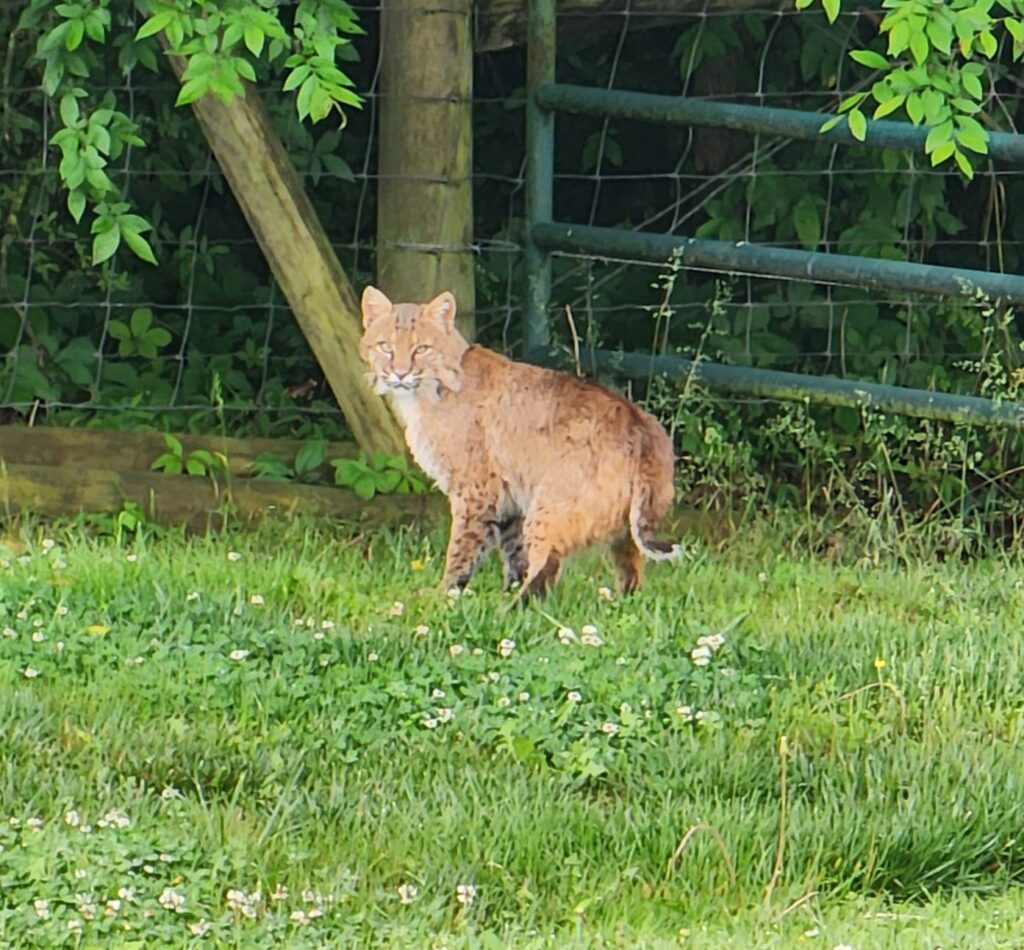
COUNTY LINE — Local pet owners in the Flat Creek and County Line communities may want to keep a close eye on their pets. Local resident Dawn Babian spotted a bobcat in her backyard during the day on Saturday — a rarity for southern, middle Tennessee. According to Babian, the animal appeared to be getting ready to pounce on her house cat. The bobcat got within about 20 feet of her back porch before she noticed and successfully scared the animal away without incident.
“I happened to be looking out the door when I saw it come out of the trees and spot my cat,” Babian says. “It started across the yard in his direction. When I stepped out the door, it ran back toward the trees and stayed there until I yelled.”
Babian says she spots lots of wildlife at her home near the Moore County, Bedford County line – deer, wild turkeys, and she’s even heard a coyote or two – but this is her first bobcat sighting. On Tuesday, she told The Times that she’s kept her eyes peeled for the bobcat since her original sighting but hasn’t seen heads nor tails of the wildcat.
Native to Moore County
Bobcats are native to all parts of Tennessee, but it is fairly rare to spot one during the day. Usually, they are nocturnal hunters. According to wildlife officials, bobcats spotted during the day between April and July are most likely hunting to feed dependent young and simply seeing a bobcat during the day does not mean that the animal is rabid, sick, or aggressive.
Local vet Dr. Bryant Morton says to his knowledge he’s never treated a local pet that’s been attacked by a bobcat. However, he says he has treated multiple animals who’ve come down with bobcat fever – an often fatal tick-borne disease caused by the parasite Cytauxzoon felis. It’s called Bobcat Fever because native bobcats are considered natural hosts for the disease.
“I think locals should be wary of them just because they are natural predators, but there are likely many more around than we realize,” Dr. Morton says.
Dr. Morton and his wife, Dr. Wendy Morton, say they’ve had their own run-in with a bobcat at their nearby Flat Creek home. As the crow flies, they live just a few miles from the Babians. Wendy says she caught a bobcat attacking a goose at her pond a few years ago.
“They also have a blood-curdling scream,” Bryant says. “If you ever hear one in the woods, you’ll decided it’s time to go home real quick.”
They get their name from their stubby tail and despite their considerable size difference, they often get mistaken as cougars on wildlife camera. Unlike cougars, bobcats have prominent, pointed ears and their fur is tawny-colored with visible spots and streaks.
Not aggressive and stay hidden form humans
Though officials definitely caution locals to keep an eye on small dogs, house cats, and even chicken and ducks, bobcats are generally not aggressive and usually try to stay well hidden from humans. They also don’t normally attack pets, unless they become habituated to a food source. Things like leaving pet food outside will often encourage them to enter your yard.
They prefer ledges and rock outcroppings and can be excellent runners, climbers, and swimmers. During kitten season they make dens in hollow logs, caves, brush piles, and even rock crevices. Bobcats are also territorial. Females only wander around six square miles while males can travel more than 25 miles away. This means if this momma cat is trying to feed her young, she may look for opportunities in northwest side of Moore County.
Should you encounter one, wildlife experts say you should pick up any small children or pets and make loud noises such as stomping the ground, yelling, or clapping. This is often enough to encourage the elusive bobcat to go back into hiding. They are very secretive and solidary animals who don’t interact often with humans.
Officials with the Tennessee Wildlife Resource Agency (TWRA) say that compared to other wildlife species, bobcats rarely cause conflict with human and don’t present a significant vector of disease. You can learn more about them on their official TWRA webpage by following this link. •
{The Lynchburg Times is the only locally owned and locally operated community newspaper in Lynchburg, Tennessee. We offer common-sense, fact-driven local stories written by a Lynchburg native with over 20 years of journalism experience. Click here to subscribe.}
